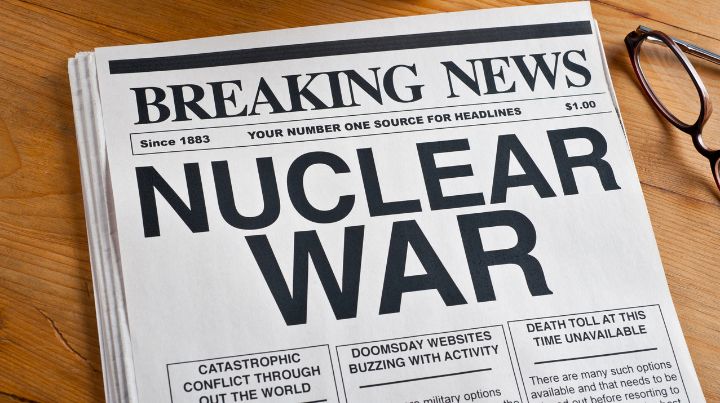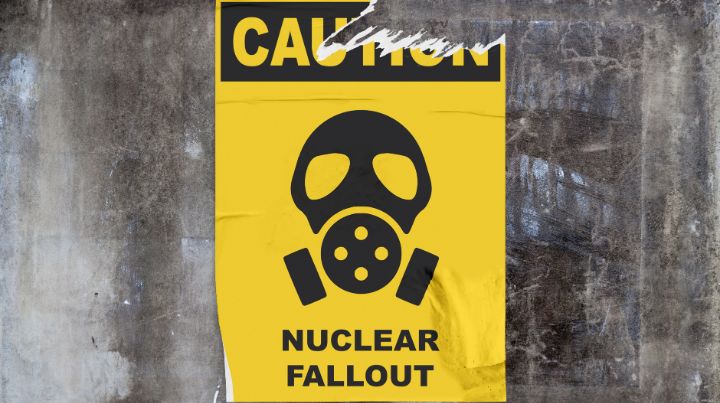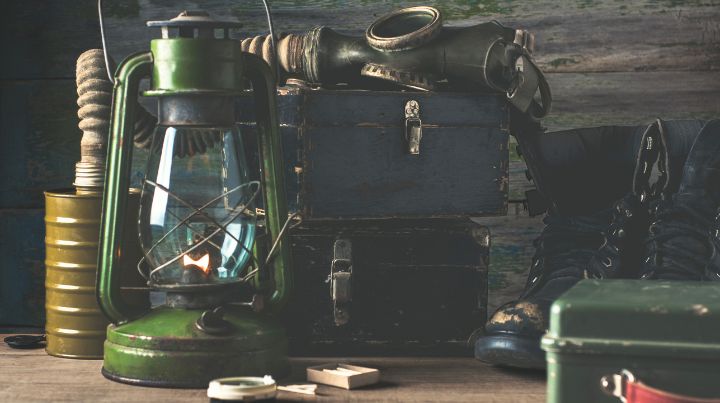How to Prep for a Nuclear Attack

The Bulletin of Atomic Scientists' 2023 Doomsday Clock Statement makes for some pretty grim reading. As of January, they had the world at 90 seconds to midnight. The scientists considered the war in Ukraine, as well as the increasing nuclear technology and stockpiling of countries such as China and India, to make their assessment.
Is There A Way to Prep for a Nuclear Attack?
Maybe you're thinking more about preparing for a potential nuclear attack. There are nuclear survival guides available, but let's go through some of the common advisories, looking at them through the lens of what we understand about what bombs do and what types of radiation will be present afterward.
During a nuclear explosion, a brilliant flash will occur as the bomb explodes in the sky. A shockwave will come almost immediately, starting fires and explosions. The shockwave will also draw material up from the ground, forming the characteristic mushroom cloud. Then, within ten or fifteen minutes, the radioactive material from the mushroom cloud will begin coming down.
How to Prep for a Nuclear Attack Depends on Your Location and Situation
If you are close to the epicenter, you can keep your spiritual house in order, and that's about it. In the Hiroshima and Nagasaki blasts, almost everything within a mile radius under the center of the bombs was destroyed. A few reinforced concrete walls were the only things left standing. Buildings were heavily damaged within a three-mile radius, and glass was broken twelve miles away.
If you are slightly farther out, the secondary fires and explosions may distract you from worrying about radiation. However, within ten or fifteen minutes, that radioactive fallout will begin to come down, which means finding shelter is absolutely necessary. Cover as much of your skin as possible as you find shelter; the blast releases neutron radiation, which ionizes all kinds of material. Even before fallout comes down from the mushroom cloud, alpha and beta particles will be present, and so will gamma rays. While covering your face definitely won't provide complete protection, it will help a little bit in blocking alpha particles.
 Where Should We Go?
Where Should We Go?
Basements are best because the layers of dirt and concrete will decrease the gamma radiation that will be present for some time. If you are in a building without a basement, go to the innermost room of the building. FEMA recommends staying there for at least 24 hours.
Why do they recommend 24 hours? Because many of the radioactive particles will have decayed by then. Though realistically, the area will be very contaminated for quite some time afterward.
So, what if you live far enough away from a target that you probably won't be vaporized, but close enough that you can expect fallout? What if you can afford to build a shelter or already have a good basement that you'd like to convert to a shelter? What would make it ideal?
Personal Fallout Shelters
If you are serious about building a shelter, you should make it somewhere you can stay for at least two weeks. Again, if you've read up a little bit on radiation, the initial release of neutron radiation will set off a round of ionization, causing normal elements to become radioactive, many of which will emit gamma rays until they decay into stable forms. This takes time, much more than 24 hours.
Advice from FEMA isn't bad, but understand that much of it is designed to keep the public from panicking. The longer you can stay in your shelter, the more time radioactive elements in the environment will have to decay, and the less exposure you will have when you do emerge.
You can find all kinds of design plans by doing an internet search for “how to build a fallout shelter.” What you decide to run with will obviously depend on your combination of budget and skill set.
What about those of us who have limited funds but already have basements or root cellars? Maybe you work in a large office building with a basement or an interior you'd like to have ready in case of an emergency. How could you begin to outfit it?
Air Supply
Well, let's start with the basics. We all need to breathe, and staying underground for any length of time means needing the ability to pump air. Now, you could go crazy spending money on some really nice ones, and if you're planning to drop tens of thousands of dollars on an awesome shelter, maybe one thousand on a really high-quality pump will be money well spent.
However, if you don't have particularly deep pockets, take a look at the instructions for building a Kearny Air Pump. Most of us cannot plan on having running water or electricity. But Army scientist Cresson Kearny designed this air pump in a way that most somewhat handy adults can build it. Children can take turns using the actual pump; it was designed to be easy to move.
Are you wondering how the air can be safe to breathe? Are you afraid that radiation will enter your shelter with fresh air?
That's a reasonable fear, but let's look again at what will be present. Remember, alpha particles only travel very short distances and are blocked by the skin. Once the fires sparked by that initial blast die down, the overwhelming majority will settle to the ground.
And beta particles? Beta particles are smaller and can travel a little farther through the air than alpha particles, but only a few feet. They, too, will settle to the ground after the initial round of fires and explosions dies down. Alpha and beta particles may get blown around in the wind, but they don't linger in the air.
Even so, the Kearny Air Pump is ideally built in such a way that air will come over a wall before entering the shelter. On page 203 of Cresson Kearny's Nuclear Survival Guide, you will see that there is a little roof built over a wall through which air comes down. The presence of the wall and roof forces any radioactive particles to settle to the ground first, before air is pumped down.
You're Going to Need Food & Water
After air, water is our next most essential item. Plan on one gallon per person per day for drinking, and then another gallon each for hygiene. Obviously, there will be wiggle room on this, depending on demographics. Small children will need less; a nursing mother will need more.
Back in my nursing mother days, I spent exactly zero hours per week thinking about nuclear survival, but if any nursing moms are reading this, plan on extra salt, too. High-quality canned fish, salt, and anything that will help you relax will be absolutely necessary. Milk won't let down if you're overly stressed (I speak from experience), and if babies can't eat, they'll fuss, and that will drive everyone all kinds of crazy.
When it comes to food, again, start by planning for two weeks' worth of food. You can check out our guide here if you need ideas to help you get started.
 Nuclear Medical Supplies
Nuclear Medical Supplies
You will also need medical supplies. We have a comprehensive list of supplies here, but a nuclear emergency calls for a few unique things to think about.
Radiation burns may develop. Radiation burns can be similar to sunburn, except that they may not present themselves for weeks after the event. There is no standard way to treat radiation burns, but skin damaged by radiation will be very sensitive. If you have a child (or adult) whining about something non-specific, just that “they don't feel good,” invisible radiation damage is a possibility.
Next, a supply of potassium iodide tablets will be good to have on hand, as well. Potassium iodide (KI) has been used since the early 1980s to treat people exposed to radiation. The Soviets widely distributed it after Chernobyl, and Americans distributed it to pilots flying near the site of the Fukushima disaster.
What is it? Well, one of the most common and dangerous isotopes formed after a nuclear blast is Iodine 131. If you saturate your thyroid with the stable form of Iodine found in KI, your body will not absorb the radioactive I131. The protective effect lasts about 24 hours. Ideally, KI is taken at the time of exposure, when it has a protective effect of 97%. However, even taken between 1 and three hours after exposure, its effect is still between 85% and 50%.
You can find a dosing regimen here. Radioactive I131 has a half-life of 8 days, which means that environmental levels will be significantly lower after a few weeks, and you can worry about other things.
Consider a Sanitation Plan
You'll need to manage waste. A composting toilet, like those in a camper, would be great. If that isn't in your budget, you could make a kitty litter toilet.
And finally, think about how to not go crazy for days or weeks stuck in a shelter. Having either a hand-crank radio or a radio with a good supply of batteries will help you make decisions about when to leave. Two-way radios will be useful if you've got prepper friends in your area because they will work without cell phone towers. Have a supply of lights and batteries. Comic books, magazines, and card games will all help pass the time. If you've got small children, think about their favorite toys. If you've got anime-obsessed teenagers, consider an investment in manga (comic books) of their favorite shows.
Final Thoughts
I hope this provides some useful food for thought. None of this is intended to make light of what a nuclear war would actually entail. Our knowledge of surviving a nuclear attack comes from Hiroshima and Nagasaki, where one bomb was dropped on each city. Bombs today are many times as powerful as they were eighty years ago. The Americans and Russians each possess many thousands. To think that major metropolitan areas would be hit by only one is delusional, a notion Khrushchev addressed in his memoirs.
America is a huge country, however, and many people aren't particularly close to large cities or military facilities. It doesn't hurt to plan ahead. An emergency supply of food, water, and medical essentials can come in handy in emergencies aside from all-out nuclear war.
Forewarned is forearmed. Even if you are only able to prepare imperfectly now, doing the best you can will give you peace of mind. It will also give you a mental roadmap of what you can do if more money or manpower becomes available to you.
Additional Resources:
Related Articles
FREE Guide
Read the Best Seller
Join Mind4Survival
Stay informed by joining the Mind4Survival! 100% Secure! 0% Spam!
Affiliate Disclosure...
Mind4Survival is a free, reader-supported information resource. If you make a purchase through our link, we may, at no cost to you, receive an affiliate commission.
Do You Want To Be Ready No Matter What?

Download our free 39-page guide with interactive, 7-Day Emergency Kit Checklist and take the first step toward real preparedness.
- Know exactly where to start.
- Save time and money.
- How-to build a complete Basic Emergency Kit.
- Level up your safety and security.
Join Mind4Survival
Stay informed by joining the Mind4Survival! 100% Secure! 0% Spam!






The Hiroshima bomb was 13 kilitonnes (13 thousand tons) of explosive power … A toy compared to the Russian Tsar Bomba, 50 megatonnes (50 Million tons) And there are bigger weapons than that out there. At 60 to 100 miles from center, they will vaporize a house. Surviving will be a true struggle. But you still have to try.
Zeolite is pulverized volcanic rock which has a negative magnetic charge. Radiation has a positive magnetic charge. Some hospitals are using it to get rid of excess radiation in patients. Order some from Amazon as well as capsules and a capsule maker. You can survive nuclear fallout or radiation from damaged nuclear power plants.
If you intend to go to your basement, to keep radiation from coming through the window place a furnace filter over the opening. Some are extremely fine filters and would hold the dust particles which the radiation attaches to. It will help.